Imagine training for months to run the Horsetooth Half Marathon, only to be sidelined by knee pain weeks before race day. Unfortunately, this is a reality for many runners who neglect proper knee care. So, how to keep knees healthy?
Studies show that the knee joint is one of the most vulnerable areas for overuse injuries. But here’s the good news: with the right approach, you can:
- Bulletproof your knees
- Reduce injury risk
- Enhance your performance
Why Runners Are Prone to Knee Injuries
Many runners unknowingly overload their knees due to poor mechanics and muscle imbalances.
Here’s why:
- Quad Dominance: Many runners rely heavily on their quadriceps while running, which increases force on the knee joint instead of distributing it throughout the lower body.
- Weak Hip Stability: Weak glutes and hip abductors lead to improper load absorption, causing excess strain on the knees.
- Improper Running Mechanics: Poor stride patterns, lack of shock absorption, or improper foot strike can place unnecessary stress on the knees.
- Overtraining & Mileage Increases: A sudden spike in mileage without proper adaptation can push tissues past their tolerance, leading to issues like patellar tendonitis and stress fractures.
Ignoring these factors can result in chronic knee pain, forcing you to cut back on mileage—or worse, stop running altogether.
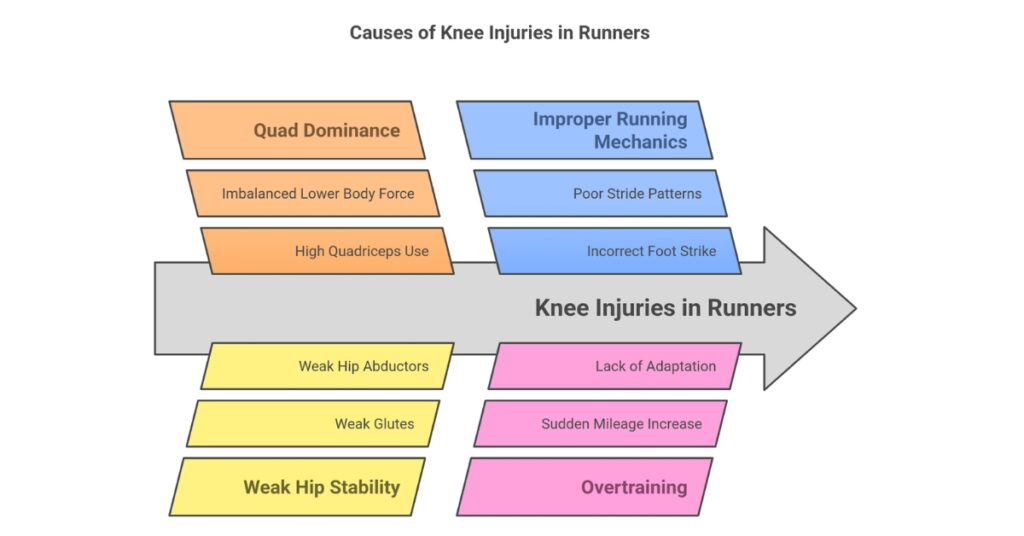
Common Knee Injuries
Running is a fantastic way to stay fit, but when it comes to knee injuries, knowledge is your first line of defense.
The knees are complex joints that support a large portion of your body weight and are especially vulnerable during high-impact activities that involve repetitive pounding, like running.
Let’s break down the most common injuries that can threaten your ability to stay active and maintain healthy joints.
Runner’s Knee (Patellofemoral Pain Syndrome)
Runner’s knee is one of the most frequent causes of joint pain in active people.
You’ll usually feel a dull ache around or behind the kneecap, especially when your knees are bent—during stairs, squats, or sitting for a long time.
It’s often caused by:
- Poor alignment or tracking of the kneecap
- Weakness in key muscle groups, particularly the quadriceps and hip stabilizers
- Lack of supportive shoes or running with improper mechanics
Strength training and mobility work focused on the hips and quads can help keep your knees healthy and reduce this kind of stress.
Iliotibial Band Syndrome (IT Band Syndrome)
The IT band runs along the outside of your thigh, and when it becomes tight or inflamed, it rubs against the knee joint.
Symptoms include sharp, stabbing pain on the outer knee—especially noticeable after a few miles into a run.
You’re more at risk if you:
- Rapidly increase mileage or intensity
- Run on sloped surfaces
- Have muscle imbalances or poor running form
To manage IT band issues, foam rolling and glute-focused strength work can restore balance and reduce joint stress.
Patellar Tendonitis (Jumper’s Knee)
Patellar tendonitis involves inflammation of the tendon connecting your kneecap to your shin.
You may feel pain just below the kneecap, especially during jumping or when straightening the leg under load.
This often stems from:
- Repeated stress from hard surfaces
- Tight quads pulling on the tendon
- Weak glutes and hamstrings failing to absorb impact
Exercises like eccentric leg lifts, hamstring curls, and leg curls can help restore muscle strength without adding further injury.
If you need personalized guidance, visit Up and Running PT in Fort Collins, CO, where we specialize in running injuries for an in-depth assessment and customized strength plan.
Get in touch at (970) 500-3427 or schedule your Discovery Call today!
Meniscus Tears
The meniscus is the cartilage that cushions the knee joint. Tearing it can cause sharp pain, swelling, and a sense that your knee is locking or catching.
This can happen from a sudden twist, especially when the foot stays planted but the body rotates.
Degenerative tears are also common in older runners or those with knee arthritis.
Managing meniscus issues often requires:
- Reducing swelling with rest, ice, or physical therapy
- Adjusting your exercise program to avoid twisting motions
- Strengthening surrounding muscle groups to stabilize the joint
Ligament Injuries (ACL, MCL)
Though less common in distance runners, ACL and MCL sprains or tears can happen during abrupt changes in direction or missteps on the trail.
Signs include:
- A sudden pop or collapse of the knee
- Instability and swelling
- Pain when bearing weight or extending the leg
These injuries are serious and may require medical intervention, particularly from an orthopedic specialist.
Prevention involves building strong muscles with regular exercise, lifting weights to target weak spots, and practicing good posture during movement.
Osteoarthritis of the Knee
Over time, the wear and tear on knee cartilage can lead to knee arthritis. This degenerative condition is more likely if you carry excess weight, have had past knee injuries, or frequently train with poor mechanics.
Symptoms include:
- Morning stiffness
- Swelling after activity
- Joint pain during or after exercise
To help slow its progression:
- Maintain a healthy weight through a balanced, healthy diet
- Keep knees strong with strength training and a consistent exercise regimen
- Work with a physical therapist to adjust your routine and avoid further damage
The Bottom Line
Your knees are the largest joint in the human body, and they deserve thoughtful care. Whether it’s tweaking your exercise program, choosing supportive shoes, or incorporating hamstring curls and glute work, every small habit adds up.
If you’re feeling persistent pain or instability, don’t push through it. A few seconds of smart decision-making now can prevent weeks—or months—of further injury.
Stay proactive, stay informed, and keep moving with healthy knees.

The Long-Term Consequences of Neglecting Knee Health
Many runners feel great at lower mileage and assume their knees can handle increased training volume without additional care. But here’s what happens when knee health is ignored:
- Chronic Tendonitis: Inflammation of the patellar or quadriceps tendon can make every step painful.
- Cartilage Breakdown: Poor mechanics and excessive load can accelerate wear and tear, increasing the risk of osteoarthritis.
- Reduced Running Capacity: As pain and injuries accumulate, your ability to tolerate running diminishes, forcing you into extended recovery periods.
- Compensatory Injuries: Knee pain can alter your movement patterns, leading to hip, ankle, or lower back pain.
Key Strategies to Build Strong, Resilient Knees
1. Strength Training for Knee Stability
Incorporating strength exercises into your routine helps absorb impact and distribute load evenly through your lower body. Prioritize:
- Eccentric Quad Work: Forward step-downs, sissy squats, and slow, controlled knee extensions help improve tendon resilience.
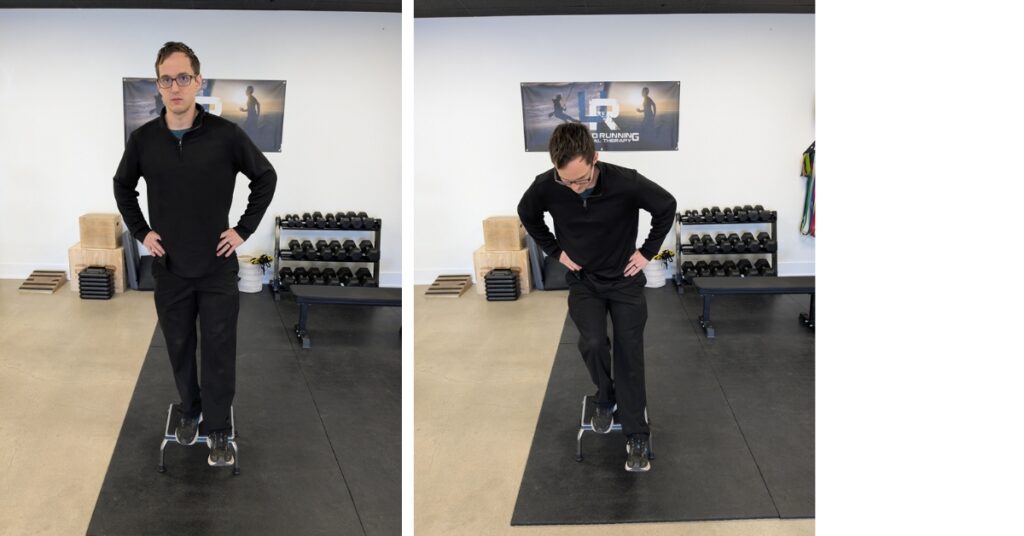
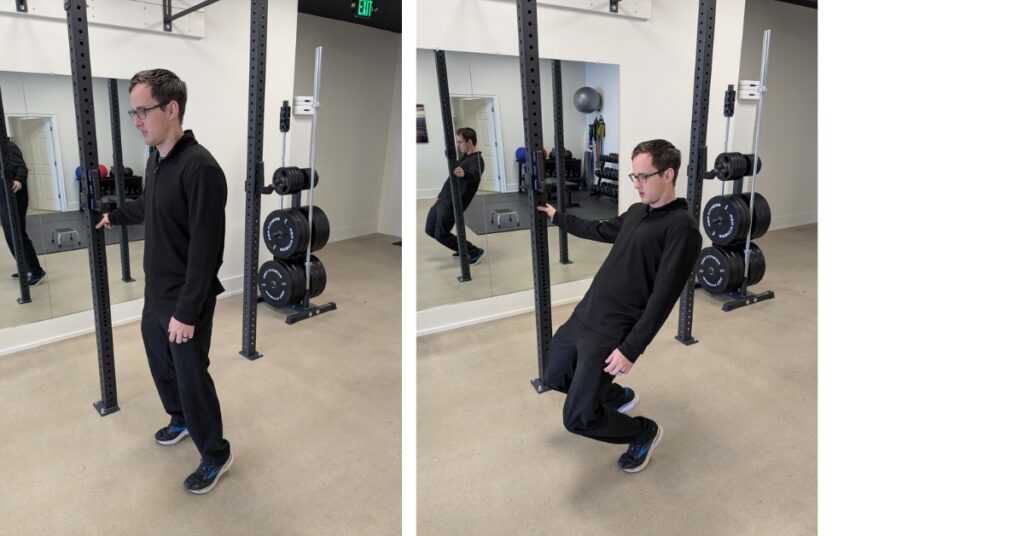
- Lateral Hip Stability Exercises: Lateral band walks, single-leg fire hydrants, and kettlebell marches enhance glute activation and stability.
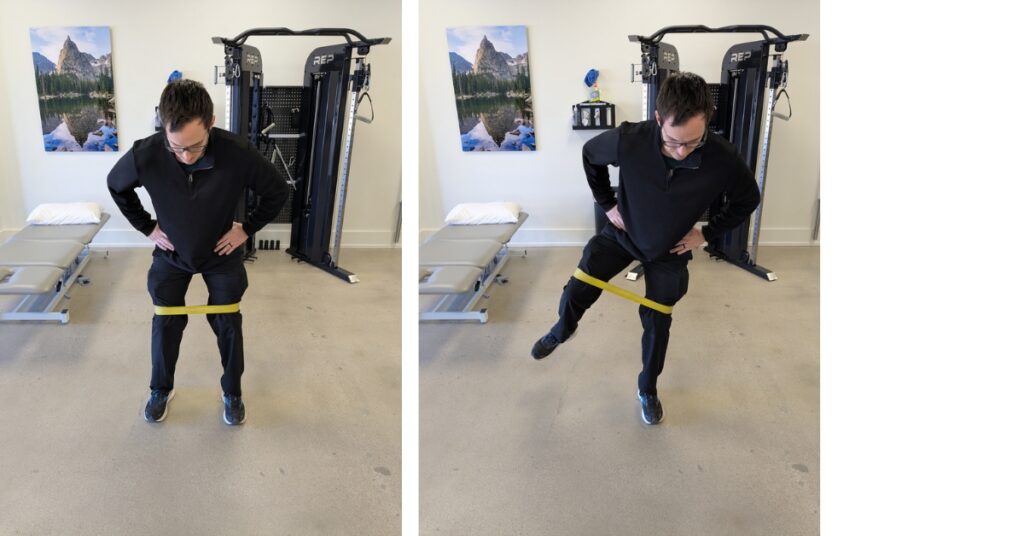
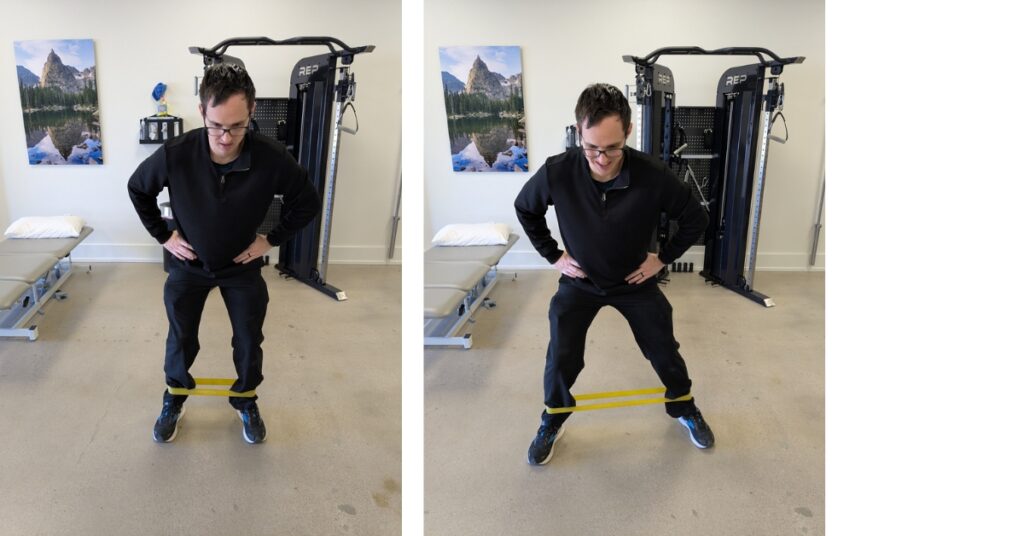
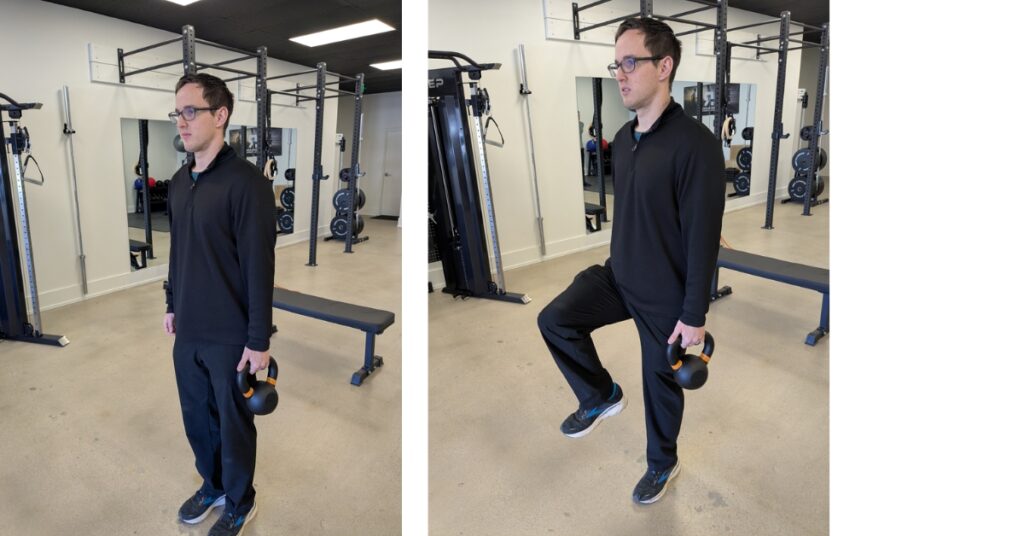
- Single-Leg Strength Training: Bulgarian split squats and single-leg deadlifts improve balance and prevent asymmetries.
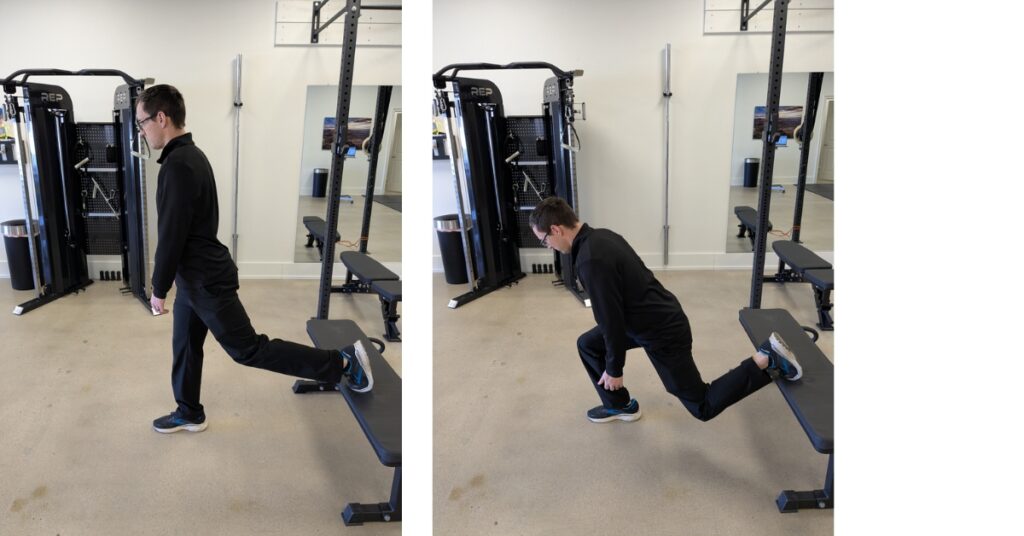

2. Mobility & Flexibility Work
Tight muscles can alter movement mechanics and increase strain on the knees. Incorporate:
- Dynamic Warm-Ups: 90/90 hip flips, leg swings, and deep lunges prepare your joints for impact.
- Post-Run Recovery: Foam rolling and static stretching (like the couch stretch) help maintain optimal tissue length and flexibility.
3. Gradual Mileage Progression
- Follow the 10% Rule, increasing mileage by no more than 10% per week to prevent overuse injuries.
- Listen to your body—if you experience persistent discomfort, scale back and incorporate recovery days.
Common Training Mistakes That Lead to Knee Pain
Even experienced runners make mistakes that compromise knee health. Avoid these pitfalls:
- Skipping Strength Training: Only running without reinforcing the supporting muscles is a recipe for knee issues.
- Neglecting Recovery: Ignoring warm-ups, cool-downs, and mobility work increases injury risk.
- Ignoring Early Pain Signs: Pushing through discomfort instead of addressing imbalances can lead to chronic problems.
Daily Habits for Bulletproof Knees
- Pre-Run Activation: Spend 5–10 minutes on dynamic stretches and glute activation exercises.
- Post-Run Recovery Routine: Stretch and foam roll.
- Consistent Strength Training: 2–3 sessions per week focusing on lower-body strength and stability.
- Wear Proper Footwear: Invest in running shoes that provide adequate support based on your gait and foot type.
Keep Your Knees Healthy: Build Stronger Knees, Run Longer
Running isn’t just about endurance—it’s about sustainability.
By taking proactive steps to strengthen and protect your knees, you can enjoy running the scenic trails of Fort Collins, from Pineridge Natural Area to the Spring Creek Trail, for years to come.
Ready to take action? Implement these strategies and see how they transform your running performance.
Finding Guidance and Help for Healing Injuries
If you need personalized guidance, visit Up and Running PT in Fort Collins, CO, where we specialize in running injuries for an in-depth assessment and customized strength plan.
Your Next Step: Prioritize Knee Health Today!Get in touch at(970) 500-3427 or schedule your Discovery Call today!

